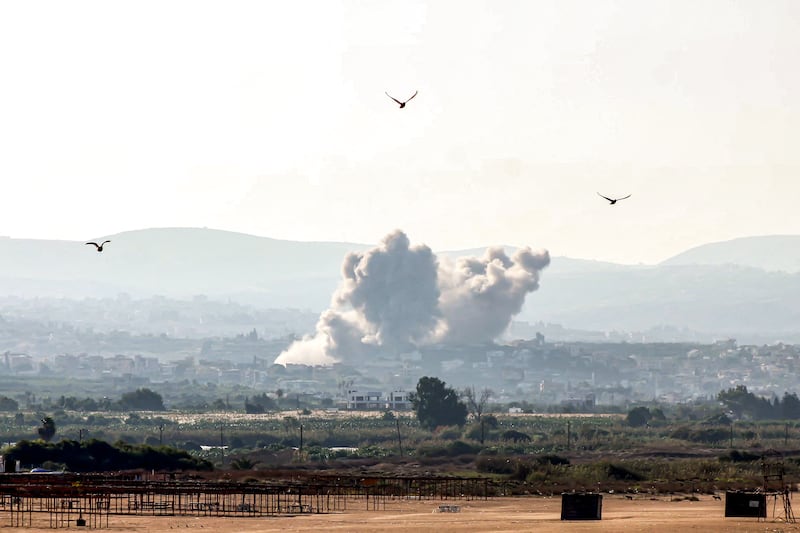Lebanon’s Hizbullah said on Wednesday its fighters had pushed back advancing Israeli forces in clashes along the length of the border, including in a village where Israeli troops had been filmed hoisting an Israeli flag.
Hizbullah has been launching rockets against Israel for a year in parallel with the Gaza war and is now fighting it in ground clashes that are spreading along Lebanon’s mountainous frontier with Israel.
The Iran-backed group said it had fired several rocket salvoes at Israeli troops near the village of Labbouneh in the western part of the border area, close to the Mediterranean coast, and had managed to push them back.
Video footage posted on social media showed three Israeli soldiers raising their country’s flag in Maroun el-Ras, the first time for decades they are known to have done so on Lebanese territory Israel occupied from 1982-2000. Reuters confirmed the location based on visible geographic features.
Situation in Gaza is ‘abhorrent and unbearable’, Ursula von der Leyen says
EU leaders agree the situation in Gaza is ‘dire’ – but that’s where agreement ends
Israel stops aid to northern Gaza, officials say, as clans deny Hamas is stealing it
Refusal by EU states to address ‘catastrophic’ Gaza situation is incomprehensible, Martin says
Israel’s military said about 40 projectiles were launched in one barrage at the port city of Haifa, some of which were intercepted while others fell in the area.
Israeli ambulance workers said two people were killed in strikes on Kiryat Shmona near the border and at least six were wounded in Haifa.
Israel, meanwhile, launched air strikes including at targets far from the border combat zone. The Lebanese health ministry said four people were killed and 10 wounded by a strike in the town of Wardaniyeh, north of Sidon along the coast.
The escalation in Lebanon, after a year of war between Israel and Hamas in Gaza, has raised fears of a wider Middle East conflict that could draw in Iran and Israel’s superpower ally the United States.

In recent weeks Israel has carried out a string of assassinations of top Hizbullah leaders and launched ground operations into south Lebanon that expanded further this week.
Israel has said that troops from as many as four divisions have operated in Lebanon since the first announcement of the ground operation on October 1st. It has not confirmed that they have established a permanent presence there.
Its bombardment of Lebanon has killed more than 2,100 people, most of them in the last two weeks, and forced 1.2 million people from their homes. Israel says it has no choice but to strike Hizbullah so that tens of thousands of Israelis can return to homes they fled under Hizbullah rocket fire.
Israel last fought a major war against Hizbullah in 2006.
Overnight, Israel again bombed Beirut’s southern suburbs. The densely-populated district has been abandoned by many residents.
US president Joe Biden spoke on Wednesday with Israeli prime minister Binyamin Netanyahu about possible Israeli retaliation on Iran for an Iranian missile strike on October 1st.
The call was “30 minutes long”, “direct” and “productive” and included discussions on a potential attack on Iran, White House spokesperson Karine Jean-Pierre said.
Vice-president Kamala Harris was reported to have joined in on the call. The Middle East has been on edge awaiting Israel’s response to the strike, which Tehran carried out in retaliation for Israel’s escalation in Lebanon.
Elsewhere, at least 45 people were killed in Israeli military strikes on Gaza in the previous 24 hours, Palestinian medics said on Wednesday, as the UN warned 400,000 people are trapped in the north of the enclave.
Israeli forces pressed on with a raid on the Jabilia refugee camp in the north of Gaza. The Israeli military says the raid, now in its fifth day, is intended to stop Hamas fighters staging further attacks from Jabilia and to prevent them regrouping.
It has repeatedly issued evacuation orders to residents of Jabilia and nearby areas, but Palestinian and UN officials say there are no safe places to flee to in the Gaza Strip.

The Palestinian Civil Emergency Service said it had received unconfirmed reports that dozens of Palestinians may have been killed in Jabilia and other areas of northern Gaza, but is unable reach them because of Israeli bombardments.
“At least 400,000 people are trapped in the area,” Philippe Lazzarini, the head of the UN aid agency for Palestinian refugees, Unrwa, posted on X on Wednesday.
Israel says Hamas uses residential areas as cover in Gaza, including schools and hospitals. Hamas denies this.
In one Israeli strike overnight on a house in a suburb of Gaza City, nine people of the same family were killed, medics said. Others were killed overnight in central areas of the Strip.
Israel began its war against Hamas in Gaza after fighters from the Palestinian militant group attacked southern Israeli communities on October 7th, 2023, killing about 1,200 people and taking about 250 hostage, according to Israeli tallies.
Nearly 42,000 Palestinians have been killed in the Israeli offensive, the Gaza health ministry says. Most of Gaza’s 2.3 million people have been displaced and much of the enclave has been laid to waste. – Reuters














